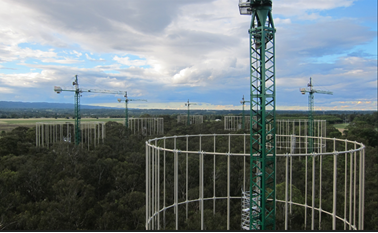Challenging assumptions about the impact of elevated CO2 on Eucalyptus woodlands

One of the likely effects of rising CO2 concentration in the atmosphere is an increase in plant water use efficiency. This is due to the expected enhancement of photosynthesis under future atmospheric CO2 concentrations, together with a partial closure of plant stomata (The pores on the leaf surface that open and close to allow plants to exchange carbon for water). For water-limited ecosystems, increased plant water use efficiency should translate into reduced ecosystem water use and increased availability of water for runoff and groundwater recharge. This was highlighted in several studies where it was demonstrated that increases in river runoff across the world were mainly due to greater plant water use efficiency under elevated CO2.
However, these studies analyzed how the vegetation has responded to past changes in the atmosphere during the 20th century, which might not necessarily be applicable to predict responses to future increases in CO2 concentration in the present century. In addition, these predictions strongly rely on experimental manipulations at the leaf or single plant level, and not the whole ecosystem. Moreover, for forests, the forecasts are only available for non-water limited regions.
Australia is the driest permanently inhabited continent and its native ecosystems are periodically subjected to periods of limited water availability. To predict freshwater availability in the face of climate and global change, there is a need to estimate the impact of future atmospheric conditions on water use for Australian ecosystems. However, quantifying the effect of elevated CO2 at the whole ecosystem level is challenging, particularly for forested ecosystems. FACE (Free Air CO2 Enrichment ) experiments are one of the few methods that allow to experimentally quantify the response of whole ecosystems to future CO2 concentrations. The EucFACE experiment, located in the native Cumberland plain forest in Western Sydney, is the only one of its kind established in a water-limited region.
FACE rings rise above the Eucalyptus canopy forest at EucFACE in western Sydney
In our field experiments, we increased the CO2 concentration to mimic the atmospheric conditions expected in the year 2050 in a mature water‐limited Eucalyptus tereticornis (forest gum) exposed to a Ca 150 μmol/mol above ambient, using the EucFACE experiment. We initially expected to find a reduction in the amount of water transpired by the trees and increased availability of water for runoff and groundwater recharge, but this was not the case. Instead, we found that there were effectively no water savings by the vegetation. Our study comprised a transition period between El Niño and La Niña cycles, thus including a broad range of water-availability and climatic conditions: from no water limitation to extremely dry and hot weather, such as the period preceding the 2013 NSW bushfires. Still, we found that ecosystem water use did not decrease under elevated CO2, regardless of the prevailing climatic conditions.
In our latest paper, which featured the cover of the July issue of Global Change Biology Journal, we argue that marginal temporary reductions in stomatal aperture at the leaf level do not drive water savings when the ecosystem is already water-limited. Our results challenge predictions from dynamic global vegetation models and suggest that the vegetation-atmosphere feedback might not be able to mitigate climate change as much as previously predicted.
Articles: ”Elevated CO2 did not affect the hydrological balance of a mature native Eucalyptus woodland”, Gimeno, T, McVicar, T, O’Grady, A., Tissue, D., Ellsworth, D. Global change biology. 24(7): 3010-3024., doi.org/10.1111/gcb.14139
